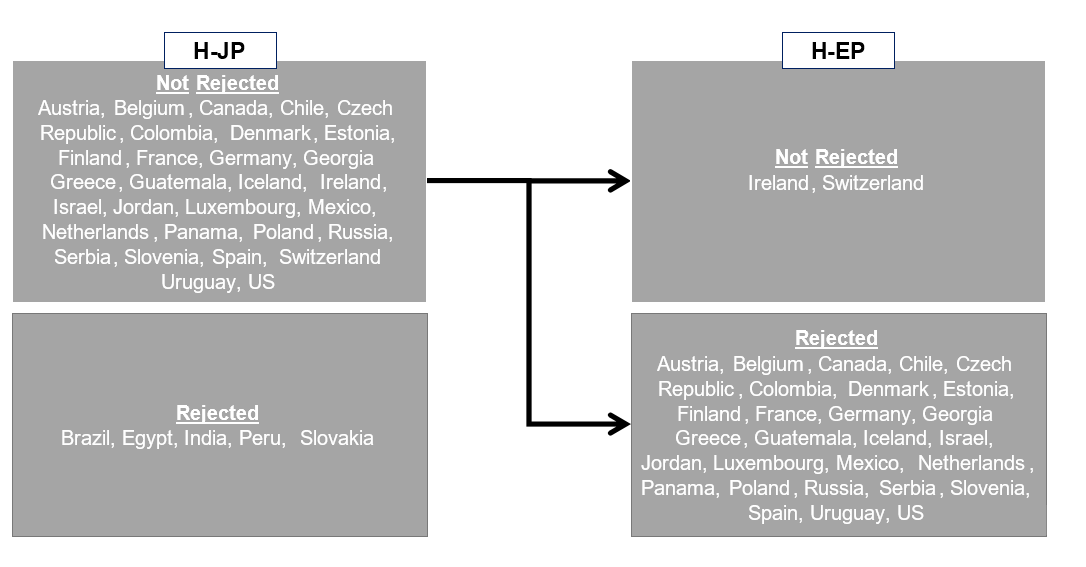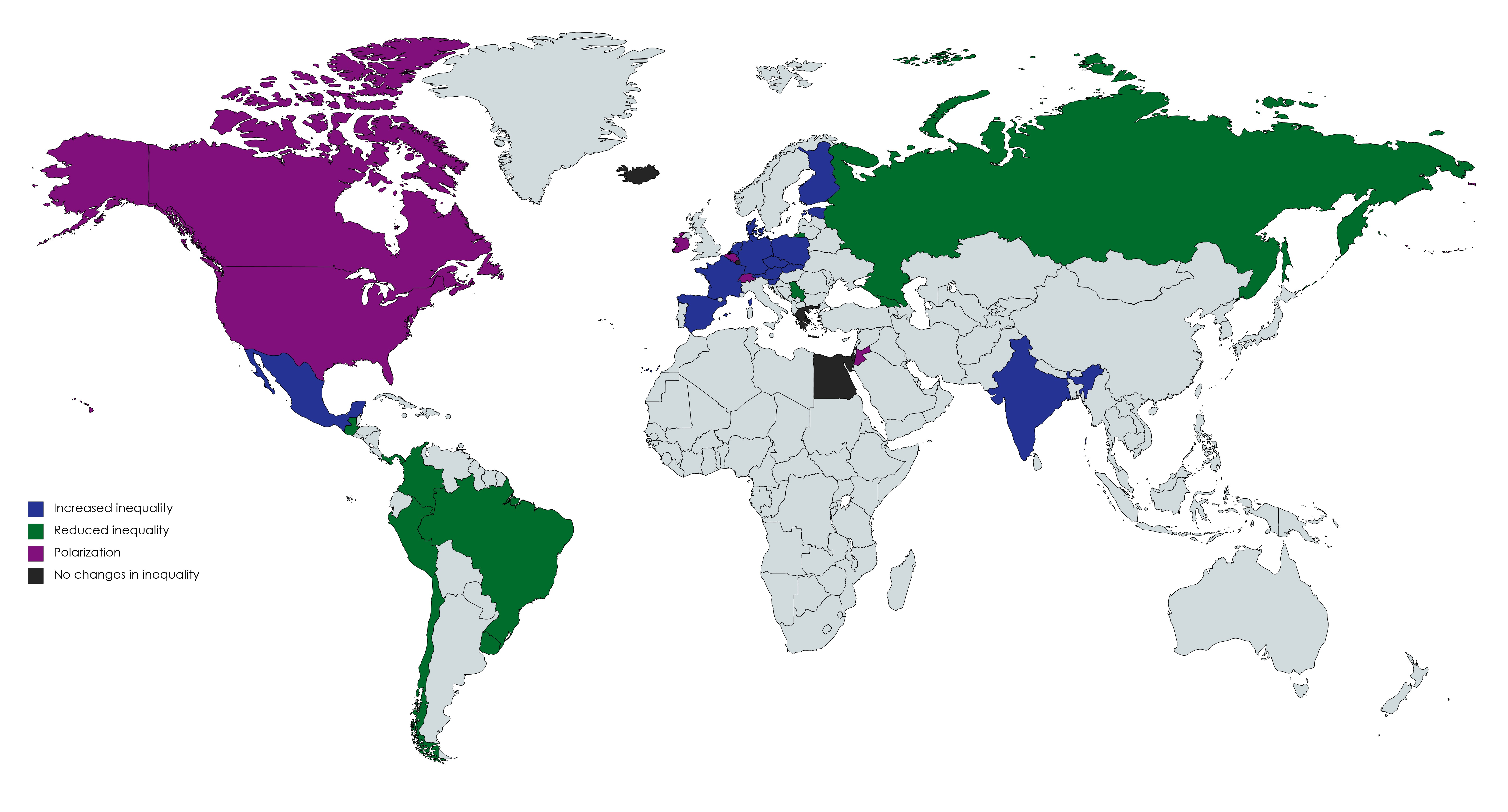Issue, No.16 (December 2020)
De-routinization of Jobs and Polarization of Earnings – Evidence from 35 Countries
Background
A large portion of the recent labor market literature has focused on the dynamics of labor demand and supply at the occupational level. It documents simultaneous growth in the employment of high-skill/high-wage occupations and low-skill/low-wage occupations, with consequent deterioration of jobs in the middle of the distribution. The literature defines this U-shaped pattern of employment growth along the wage/skill distribution as “job polarization”.
A most influential explanation for job polarization has been proposed by Autor et al. (2003) and is commonly known as the Routine-Biased Technological Change (RBTC) hypothesis. The RBTC hypothesis relates employment polarization to the rapid improvements in information and communications technologies. In particular, technological progress, in the form of computerization and automatization of labor inputs, is a substitute for workers performing routine tasks. This automation of routine tasks raises the relative demand for workers who can perform complementary non-routine tasks that cannot be easily automatized (i.e. problem-solving, creativity, situational adaptability and in-person interactions). While routine tasks are typically characteristic of middle-skilled jobs (production, clerical and sales occupations), non-routine activities are mostly concentrated at both tails of the wage/skill distribution: managerial, professional and technical occupations at the top; personal service occupations at the bottom. According to the RBTC hypothesis, the decreasing costs of technology over the last decades have exogenously driven the adoption of technological devices that replace middle-wage/routinized occupations and increase labor demand for non-routine occupations at the tails of the distribution, leading to polarization of the workforce with potential relevant implications for the evolution of overall inequality.
Research Question and Methodology
We contribute novel evidence for two highly debated questions in the literature, i.e. whether job polarization is a local or global phenomenon and whether it entails distributional effects. Our paper (Longmuir et al., 2020), therefore, tests two hypotheses in the RBTC framework:
- Job Polarization Hypothesis (H-JP): In the last decades, countries experienced decreasing employment shares in routine-intensive occupations and increasing shares in non-routine-intensive ones.
- Earnings Polarization Hypothesis (H-EP): Job polarization implies rising earnings shares for the lower and upper earnings class, while the earnings share of the middle class hollows out.
Our analysis focuses on 35 LIS-ERF countries characterized by different economic and political systems: Austria, Belgium, Brazil, Canada, Chile, Colombia, Czech Republic, Denmark, Estonia, Egypt, Finland, France, Georgia, Germany, Greece, Guatemala, Iceland, India, Ireland, Israel, Jordan, Luxembourg, Mexico, Netherlands, Panama, Peru, Poland, Russia, Serbia, Slovakia, Slovenia, Spain, Switzerland, US, and Uruguay. This database represents the largest available harmonized micro-database providing detailed income and socio-demographic information at the individual level.
We analyze H-JP by calculating the change of employment- and earnings shares for different occupational groups over time. For H-EP, we apply decomposition methods developed by Firpo et al. (2009) based on re-centered influence functions (RIF).
This paper contributes to the literature by providing a comprehensive international test of the employment and earnings polarization hypotheses as well as an assessment of their relevance for inequality dynamics. Unlike previous research, we investigate the unconditional distributional effects of job polarization, overcoming the limitations of an occupation-based approach and accounting for both between and within– occupational classes determinants of inequality, claiming that both dimensions must be considered in distributional analysis.
Results
We do not reject H-JP, as we find decreasing employment and earnings shares in routine occupations in 30 out of 35 analyzed countries consistent with the RBTC framework. The right panel of Figure 1 lists the result of our descriptive analysis. We reject H-JP only for Brazil, Egypt, India, Peru, and Slovakia. Therefore, we conclude that the RBTC hypothesis constitutes an important theoretical framework appropriate for studying the evolution of the composition of the employed workforce internationally.
Figure 1: Results: H-JP and H-EP

Note: Summary of the results of our analysis considering the job- and earnings polarization hypothesis.
We reject H-EP, because our analysis does not suggest a close link between employment and earnings polarization in 33 out of the 35 analyzed countries, confirming the overall weak predictive power of the RBTC hypotheses for distributional analysis. The left panel of Figure 1 lists the result for H-EP, which cannot be rejected for Ireland and Switzerland. Our estimates suggest that the increased (decreased) demand for non-routine service (routine) occupations does not coincide with increasing (decreasing) returns in bottom (middle) quantiles.
Figure 2 provides a graphical overview of earning inequality patterns. We find overall employment and earnings polarization in a restricted subset of countries: Belgium, Canada, Ireland, Jordan, Switzerland, and the United States. However, only in Ireland and Switzerland, does our analysis suggest that U-shaped effects of job de-routinization drive the polarization of the earnings distribution. In Belgium, Jordan, and the United States, job polarization implies increasing inequality, suggesting that employment de-routinization per se cannot explain the observed polarization and that other factors have driven the growth of bottom-tail earnings. In almost all European countries under analysis, i.e. Austria, Czech Republic, Denmark, Estonia, Finland France, Germany, Netherlands, Poland, Slovenia, Slovakia and Spain, as well as in Mexico and India, we observe increasing earnings inequality. In Georgia, Jordan, Russia, and in countries in Central and South America, i.e. Brazil, Chile, Colombia, Guatemala, Panama, Peru, and Uruguay, we identify decreasing inequality. Inequality patterns in Egypt, Greece, Iceland, Israel, and Luxembourg are rather stable over the time span considered. De-routinization effects, ceteris-paribus, are extremely heterogeneous and, in general, do not predict overall quantiles growth patterns.
Figure 2: Inequality patterns in 35 countries

Note: Results by country, based on our analysis. Blue indicates increased inequality, green represents reduced inequality, purple indicates polarization, and black indicates no changes in inequality.
In a last step, we descriptively scrutinize how changes in the employment structure correlate with changes in inequality between and within occupational classes separately. Consequently, we link H-JP and H-EP results in order to understand why earnings prove to be unresponsive to changes in employment composition. Two major findings result: first, we do not find any significant reduction (increase) in inequality between service (abstract) and routine workers. Such results corroborate the RIF decomposition results explained above: changing returns between occupations mitigate the composition effects of job polarization and are key determinants for overall earnings growth. Second, within occupations dynamics seem to play the major role for the distributional analysis, although it is typically neglected in RBTC literature.
Our analysis strongly supports the findings by Goos and Manning (2007), Böhm et al. (2019), and Hunt and Nunn (2019), questioning the earnings polarization hypothesis and, ultimately, raising concerns about the importance of RBTC for earnings inequality. Our results may corroborate the hypothesis that labor market institutions, such as unions, the minimum wage, and contracts conditions, to some extent alleviate externalities resulting from the increase in job polarization. We urge future research to deepen the understanding behind the interrelation between exogenous de-routinization forces and (endogenous) political control of labor market policies.
References
| Autor, D. H.; Levy, F.; Murnane, R. J. (2003). The skill content of recent technological change: An empirical exploration. The Quarterly Journal of Economics, 118 (4):1279–1333. |
| Böhm, M. J.; von Gaudecker, H.-M.; Schran, F. (2019). Occupation, Growth, Skill Prices, and Wage Inequality, CESifo Working Paper No. 7877. |
| Firpo, S; Fortin, N. M.; Lemieux, T. (2009). Unconditional quantile regressions. Econometrica, 77(3):953–973. |
| Goos, M. and Manning, A. (2007). Lousy and lovely jobs: The rising polarization of work in Britain.The Review of Economics and Statistics, 89(1):118–133. |
| Hunt, J. and Nunn, R. (2019). Is employment polarization informative about wage inequality and is employment really polarizing? IZA Discussion Papers, (12472). |
| Longmuir, M; Schröder, C.; Targa, M. (2020). De-routinization of Jobs and Polarization of Earnings – Evidence from 35 Countries, LIS Working paper Series No. 796, LIS Cross-National Data Center in Luxembourg. |
